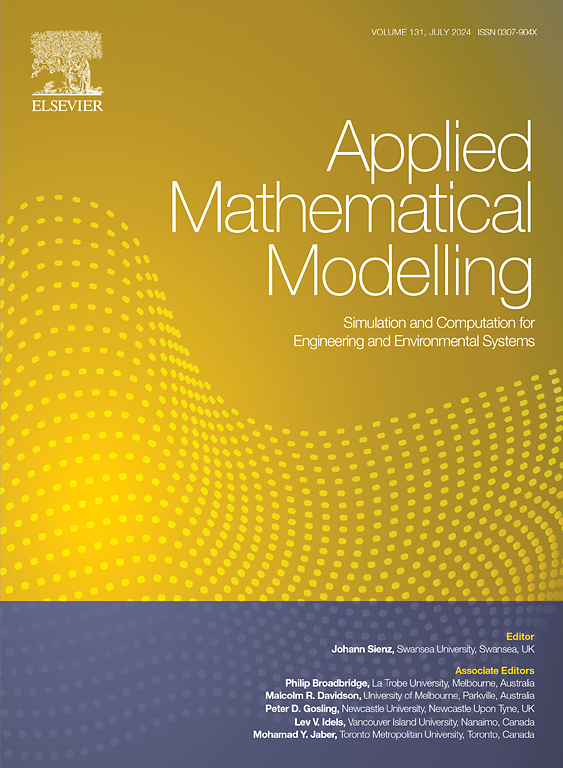A new inventory routing problem with route and schedule unpredictability
IF 4.4
2区 工程技术
Q1 ENGINEERING, MULTIDISCIPLINARY
引用次数: 0
Abstract
The inventory routing problem (IRP) in a retail supply chain setting allows for the simultaneous optimisation of delivery schedules, vehicle routes, and delivery quantities. The IRP relies on the adoption of a vendor-managed inventory strategy which has the potential to reduce transportation, inventory, and stock-out costs in a supply chain. In this paper, we introduce a mathematical model for a new IRP variant, the heterogeneous fixed fleet IRP with time-windows (HeFIRPTW) with route and schedule unpredictability, in the form of a bi-objective mixed-integer linear programming problem. This model simultaneously incorporates route and schedule unpredictability aimed at mitigating inherent safety and security threats experienced during the transportation of valuable goods. Delivery routes and schedules are generated that minimise the operational costs incurred whilst also ensuring that route segments are not traversed too regularly and that customers are not visited during overlapping daily time intervals. The feasibility of adopting an exact ϵ-constrained model solution method is investigated empirically by solving small, adapted benchmark instances of the problem. An investigation into the model solution complexity for varying problem sizes reveals that unpredictability, particularly with tightened constraints, increases the computational time. The complexity implications of multiple vehicles and the imposition of time-windows are also examined. The results highlight the computational demands of the proposed model, demonstrating a clear need for a faster, perhaps approximate, solution approach capable of generating high-quality solutions for realistic problem instances within reasonable time-frames.
一种新的具有路径和进度不可预测性的库存调度问题
零售供应链中的库存路线问题(IRP)允许同时优化交付时间表、车辆路线和交付数量。IRP依赖于采用供应商管理的库存策略,该策略有可能减少供应链中的运输、库存和缺货成本。本文以双目标混合整数线性规划问题的形式,建立了一种新的IRP变体——具有路线和调度不可预测性的异构固定车队IRP (HeFIRPTW)的数学模型。该模型同时结合了路线和时间表的不可预测性,旨在减轻贵重物品运输过程中遇到的固有安全和安保威胁。生成配送路线和时间表,以最大限度地降低运营成本,同时确保路线段不会过于频繁地穿越,并且不会在重叠的每日时间间隔内访问客户。通过求解该问题的小型、自适应基准实例,对采用精确ϵ-constrained模型求解方法的可行性进行了实证研究。对不同问题规模的模型解决复杂性的研究表明,不可预测性,特别是在严格的约束下,增加了计算时间。多重车辆的复杂性影响和强加的时间窗也进行了审查。结果突出了所提出的模型的计算需求,表明明确需要一种更快的,也许是近似的解决方法,能够在合理的时间框架内为现实问题实例生成高质量的解决方案。
本文章由计算机程序翻译,如有差异,请以英文原文为准。
求助全文
约1分钟内获得全文
求助全文
来源期刊

Applied Mathematical Modelling
数学-工程:综合
CiteScore
9.80
自引率
8.00%
发文量
508
审稿时长
43 days
期刊介绍:
Applied Mathematical Modelling focuses on research related to the mathematical modelling of engineering and environmental processes, manufacturing, and industrial systems. A significant emerging area of research activity involves multiphysics processes, and contributions in this area are particularly encouraged.
This influential publication covers a wide spectrum of subjects including heat transfer, fluid mechanics, CFD, and transport phenomena; solid mechanics and mechanics of metals; electromagnets and MHD; reliability modelling and system optimization; finite volume, finite element, and boundary element procedures; modelling of inventory, industrial, manufacturing and logistics systems for viable decision making; civil engineering systems and structures; mineral and energy resources; relevant software engineering issues associated with CAD and CAE; and materials and metallurgical engineering.
Applied Mathematical Modelling is primarily interested in papers developing increased insights into real-world problems through novel mathematical modelling, novel applications or a combination of these. Papers employing existing numerical techniques must demonstrate sufficient novelty in the solution of practical problems. Papers on fuzzy logic in decision-making or purely financial mathematics are normally not considered. Research on fractional differential equations, bifurcation, and numerical methods needs to include practical examples. Population dynamics must solve realistic scenarios. Papers in the area of logistics and business modelling should demonstrate meaningful managerial insight. Submissions with no real-world application will not be considered.
 求助内容:
求助内容: 应助结果提醒方式:
应助结果提醒方式:


